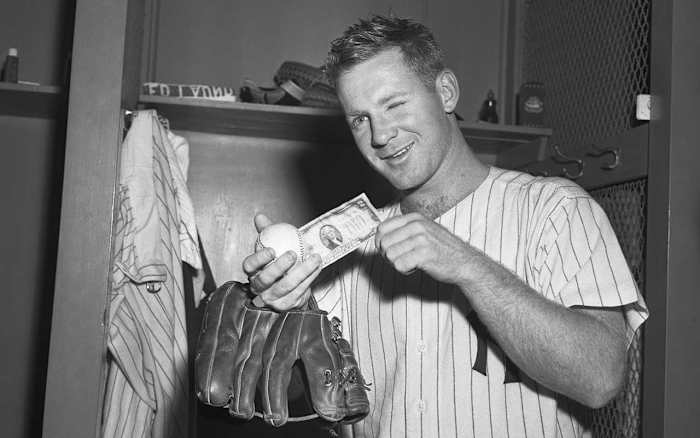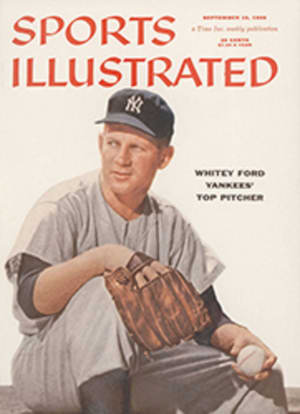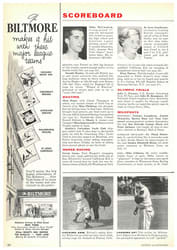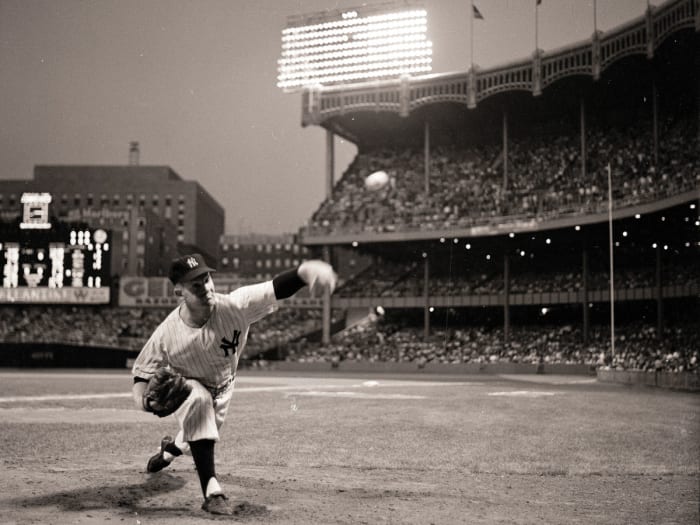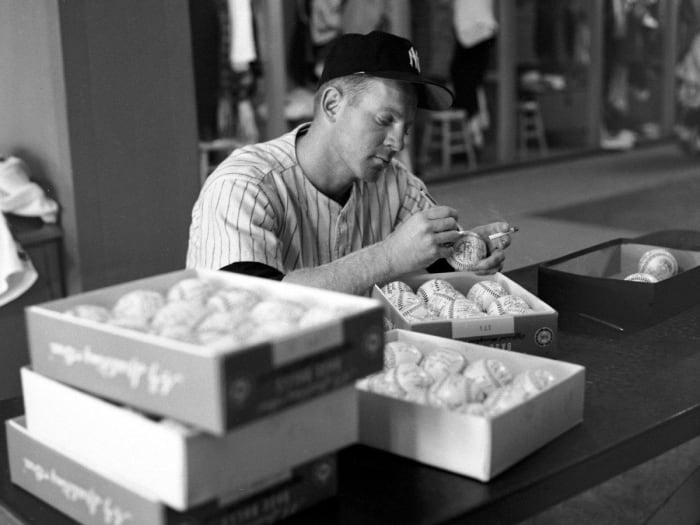THE PITCHER WHO COULD WIN THE SERIES
The New York Yankees, who this week are tucking in the edges of their 22nd pennant, have dominated the American League all season. There seemed no reason to believe in the spring that they would not win the pennant. There seemed no reason to doubt them in midsummer. And now, going toward autumn and the imminent end of the pennant race, their commanding lead is concrete evidence of their overwhelming strength.
And yet hope has persisted all season among those teams which made a serious effort to challenge the Yankees (the Indians, the White Sox and the Red Sox), hope that perhaps New York would collapse and come back to the field. The reason for hope? Yankee pitching was suspect. It was erratic, uncertain, hardly of the quality of Yankee fielding, Yankee hitting, Yankee base running. It was the Achilles heel of this otherwise outstanding team; and, the argument ran, as a chain is only as strong as its weakest link, so were the Yankees only as strong as their pitching.
For of all the dozens and dozens of timeworn maxims governing the thoughts of those who follow the great game of baseball, few are as valid as the one that says, "Pitching is 75% of the game."
This one is attributed to Connie Mack and is accepted as the truth. There are deviationists who say the proportion should be only 50% or as much as 90% or some equally inane precise figure. But nearly everyone agrees that as a general rule a bad team with a good pitcher will beat a good team with a bad pitcher. Pitching, in a word, is strength. Lack of pitching is weakness.
But the Yankees seemingly defied the maxim, and they certainly destroyed hope. They won steadily, and though they slumped at times they rallied and took the games they had to take, those keystone victories that hold up the arch of a six-or seven-game lead. Slowly the realization grew that the Yankees, rather than defying the maxim, had upheld it.
It was true enough that the pitching was shaky: four of the five pitchers Casey Stengel had counted on as his starters in the spring failed him. Bob Turley, the speed-baller, had trouble with his control. Don Larsen followed one well-pitched game with a terrible one. Tommy Byrne, the surprise of 1955 (first in winning percentage in the American League, with 16 wins against five defeats), had bad luck as a starting pitcher in 1956 and was converted into a regular (and reasonably effective) relief pitcher. Maurice McDermott, the once skinny and lightning-fast left-hander obtained from Washington, had more weight and less speed and was an almost complete bust.
But young Johnny Kucks, the stringbean from New Jersey, quietly and confidently moved into the rotation, pitched more innings and won more games than anyone else on the staff. Tom Sturdivant, a relief pitcher by trade, put a newly polished knuckle ball to good use as a starter and took up a good deal of the slack left by the defection of Turley, Larsen, Byrne and McDermott.
And Edward Charles (Whitey) Ford, ace of the staff in the spring, remained ace of the staff in September, pitching key games against the best pitchers in the league, winning games that had to be won. The Achilles heel had healed itself.
In July a clear-eyed manager of one of the American League teams engaged in the futile chase of New York took it upon himself to destroy what he considers to be a myth.
"I keep hearing about this weak Yankee pitching, this terrible Yankee pitching," he said. "That's a lot of garbage. They got a hell of a pitching staff. They got depth, all the way down the line. Big guys that can throw. And Ford. You name me a better pitcher in the league than Ford. Pierce? He's as good as Ford, sure, but you think he's any better? I don't know but what I'd rather have Ford. He's tough, a tough little pitcher."
Tough? This little fellow with the knickers and the small boy's cap?
"I'll tell you one secret about Ford," said Jim Turner, pitching coach under Stengel. "He looks like a little boy out there on the mound. But he isn't. He's a man, and a big man. You ought to see the shoulders on him, and the back. He weighs 185 pounds. He's big. He's strong. People think he's one of these cuties, has to fool the batters. But don't worry about Ford. He's got plenty of stuff on the ball."
As for Ford himself, he sat in the dugout in Yankee Stadium late one afternoon before a night game and talked about himself and about pitching and about the Yankees.
"I weigh 180," he demurred gently. "I know because I just weighed myself. I don't want to get fat."
He smiled, a cheerful, amused little smile, as if this were a personal joke.
"When I tried out for the Yankees in 1946 I was five seven and weighed 140. I was a first baseman. Krichell [Paul Krichell, the Yankees' chief scout] told me I was too little to be a first baseman. He told me to try pitching. That summer I played with a team in the Journal-American League, over in the Polo Grounds. I pitched all summer, and then they came looking for me."
Ford grinned again, as if he had just thought of something funny.
"Maybe Krichell was just kidding," he said, "because I was so little. I wonder if he was. Though I could always throw pretty good.
"That summer I learned how to throw a curve. I mean, I knew how to hold it, you know, and spin it off your fingers. But that summer I learned how to throw it. The day they came to see me we won 1-0 in 11 innings. I struck out about 18 guys. The Yanks signed me when the season was over in October, just before I was 18."
Ford went to the minors, into the Yankee chain. He pitched in Class C—the second-lowest minor league classification—in 1947, Class B in 1948, Class A in 1949 and Class AAA in 1950, a steady, classic progress up the minor league ladder, climaxed in midsummer of 1950 when he was called up to the Yankees.
Ford's won-and-lost record, season by season, is remarkably constant: 13-4, 16-8, 16-5, 15-4 (combining his Kansas City and New York records in 1950), 18-6 (in 1953 after two years in military service), 16-8, 18-7 and, this year, 15-5 by the first of September. If consistency is a jewel, Ford is high-carat quality.
His record indicates that he improved markedly year by year in the minors, since he advanced into faster competition each season. He pitched extremely well for Kansas City in 1950 (6 won, 3 lost) but turned in an even better record with the Yankees (9-1) after he was called up halfway through the season.
"What you learn, pitching in the minors," Ford said, "is confidence. You learn your pitches and what you can do with them. I grew up. I got bigger and heavier. I used the fast ball. I used the curve more and more. And I learned how to throw the changeup."
Once again he smiled, a half-embarrassed, half-amused smile.
"That's all I throw now," he confessed. "Fast ball, curve, change. I tried a slider for a while one year up here, but I hurt my arm throwing it so I gave it up. It's a good pitch but not for me. It hurts me. You see, when you throw a slider you sort of snap the ball."
He demonstrated, showing with his bulky, reddish forearm how the hand follows straight down after a fast ball and twists all the way through after a curve. With the slider, he demonstrated, you more or less stop the motion abruptly halfway through. He shrugged.
"It hurt my arm, so I don't use it. Just the fast ball, the curve and the change. My fast ball is all right, but I can't overpower a guy with it. I have to pitch to spots. My control is good, but it's not the kind of control that's over the plate all the time. I walk a lot of guys now. But maybe I'd rather walk them than let them hit. Maybe the next guy isn't as good a hitter.
"My greatest asset as a pitcher is knowing the hitters. Ed Lopat taught me that. He had to know every batter's weakness. I watch the batters from the bench. I talk to Turner. I talk to the other pitchers.
"You take———[he mentioned the name of a right-handed batter]. The way I'd. work on him, maybe, would be to start him off with a good curve. He likes to swing at my first pitch because he knows I try to get the first pitch in on him. But I know he knows that, so I try to give him something he'll go for that's not too good. So maybe I'll give him a good curve a little low, a little inside. Let's say he fouls it off. All right. One strike. Then I'd give him a fast ball in here."
He moved his hand across his chest.
"I'd keep it inside," he cautioned. "I wouldn't try to hit the plate. I don't want him to hit my fast ball. I'd keep it inside, close to him. All right. One and one. Then I'd try a change, maybe, just to upset his timing a little. Say it misses. Ball two. Then maybe I'd try a fast ball right down the middle, right across the middle of the plate. He wouldn't be expecting that. All right. Two and two. Then I'd try to give him a real good curve, put everything I have on it."
He did not say whether the curve was a ball or a strike, but he sat back, contented, thinking of the real good curve.
"I'm lucky in that I can throw a curve when it's three and two. Not many pitchers can do that. They get behind, they have to come down the middle. A pitcher like me without overpowering stuff can't just throw the ball over the plate. I have to pitch to spots. A guy like Score or Newcombe or Turley can fire the ball, and if he gets it anywhere over the plate he's tough to hit."
He mentioned the batter again.
"Of course, if it's 10-1 our favor or theirs I wouldn't work on him. Just give him good curves. I wouldn't let up, I'd throw hard, but I wouldn't work on him."
Ford talked about the Yankee pitching staff. He mentioned Kucks and how the tall right-hander had gained not only 15 pounds over the past season but a good deal more confidence in his own ability, and Sturdivant and the knuckle ball the latter has utilized so well. He discussed the other pitchers.
"I think our staff's pretty good," he said. "Just because we don't have a lot of 20-game winners, people say it isn't any good. I think it's a good staff. Most of our guys have good records. Go look at them. They talk about Cleveland all the time and their pitching staff, but last year our staff had a better earned run average than theirs did. We got a good staff."
A search of the records bore Ford out. Three of this year's disappointments—Turley, Larsen and Byrne—had a combined record on September 1 of 22 victories and 10 defeats. True, three men were doing the work of one (one like Don Newcombe, say), which is wasteful, but the work they were doing was, in retrospect, highly satisfactory.
Part of the good record of this part-time, hither-and-yon pitching staff must stem, of course, from the hitting and fielding prowess of the Yankees' Hitting & Fielding Department, and part from the skill with which Casey Stengel manipulates his starters and his relief pitchers. But part, too, may be the result of something that Ford touched on in an impromptu discussion of tension and excitement.
"I get more nervous sitting on the bench than when I'm in the game. If I could be as good a major league first baseman as I am a pitcher—I mean, if I was bigger and I could go for the distance and all—I'd rather play first base than be a pitcher. It's tough sitting on the bench between starts. You worry about everything, whether you're going to win or lose. It's easier if you're playing. Out on the field you can do something about it. I don't get nervous when I'm going to pitch a game. No, not even when it's against a real good pitcher. You get used to it."
He lifted his voice and spoke with pride. "This club always faces the real good pitchers. Pierce, Wilson, Lemon, Score, Brewer. Everywhere. Even in Washington. We get Ramos and Stobbs. You get used to it."
This, then, might be the answer to the old miracle of baseball: why an ordinary player on being traded to the Yankees turns into a superior player. He becomes used to playing against the best opposition, used to playing to the absolute limit of his own ability in order to match that opposition. The opposition then goes off and plays someone who really doesn't care, but the Yankees take on someone who does, who even on a dull, humid day in August wants desperately to beat the Yankees. Go against the best day in and day out and it becomes commonplace. When something better than the best appears it becomes not a thing to fear and wonder at but rather a new and exciting challenge, something to rise to.
Ford—despite his 180 pounds and his shoulders which, as Jim Turner pointed out, are massive—is nevertheless small compared to many of the pitchers he faces, and he does not possess the superb natural pitches of a Score or a Lemon. But he has developed his own skills to a point of high efficiency, and he has learned in the heat of competition that a Score or a Lemon, or whoever, is not impregnable. Slowly, he has built his poise and confidence until now, when he takes the pitching mound against them, he feels that he is the one to beat—he and, of course, the Yankees.
This is the Yankee characteristic. Despite Mantle and Berra, today's Yankees are no Murderers' Row band of sluggers. They are sharp, alert, capable craftsmen of a game that returns high premiums in runs and victories for just such qualities.
Not all the Yankee players have it, that special nature and knowledge and ability to play with mind and body sharp and alert, and to play better and better as the competition gets tougher and tougher. But the key Yankees do. And Edward Charles Ford, not yet and possibly never a 20-game winner, is a key Yankee. And because old Connie Mack was right, as he usually was, when he talked about pitching, Whitey Ford—certain to start the first game of the 1956 World Series and very likely at least one more after that—is an excellent bet to rise to the occasion. He did just that when he beat the Brooklyn Dodgers twice last year, and this time, with just a little bit of luck, he can prove to be the difference between Yankee defeat and victory.
Highlight
From the diary of a Giant fan who last week watched archenemy Jackie Robinson rampaging on the Polo Grounds base paths:
Robby works, works, finally walks, pigeon-toed, to first. "Go on, Robby, worry him." Ridzik looking over at first, throws ball one, ball two to Amoros, who waits, bat twitching. Robby, edging off, goes with the pitch. "There he goes! There he goes!" He beats the throw by plenty, a stolen base. Three and one. Robby jigging off second, Ridzik looking back. Ball four, and out comes Rigney. Hell, we're ahead 3-0 and we're nervous as kittens. Furillo, the Giant Killer, up. Ridzik curves one in. Robby ambling insolently off second. Three and one! Rigney up, to water cooler. Nervous as cats. Walked him! Bases loaded. Campy up now. Look at Jackie! Bouncing, bouncing off third. Look at him. Castleman holds third base like first baseman. Ridzik takes off hat. Puts it on. Robby stands eight feet , off bag, defying pitcher. Ridzik finally turns and, almost pitifully, lobs ball to third. Schoendienst in to talk to him. Robby off again. "Ooooh," from crowd, as he makes break halfway. Ball one. Robby off, breaks, halts, breaks. Ridzik watches him as he winds up. Ball two! Someone shouts, of Robby, "There is a ballplayer." Red comes in again. Sarni comes out. Boos from the crowd.
Robby again. Ridzik steadfastly ignores him. Then he looks at him, throws to plate, ball three! Crowd yowls. Ridzik gets the cripple in for a called strike. Robby whispers to Herman. Goes halfway down as excitement becomes almost unbearable. Ridzik, desperate, pitches. Ball four. Fulfillment for Brooklyn. Campy goes to first and Robby walks home, touches plate, pats Gil Hodges encouragingly, walks to bench. Behind Dodger dugout the crowd stands, stands, and applauds. Applause for walking in from third base. Afraid this is Jackie's night. More on Robby's individualism on page 25
The Difference
One of the lesser-known reasons for the Yankees' success this year has been the strength of their pitching staff. Whitey Ford, the star, has been ably backed by such as Johnny Kucks and Tom Sturdivant (right).
The depth of their hitting has also been overlooked. It is a baseball banality to talk of Yankee power, but many think of it as almost exclusively wrapped around Mantle, aided and abetted by Berra, Bauer and Skowron. Yet the Yankee bench, strongest in the league, has been a vital factor.
Casey Stengel called on his bench 149 times in New York's first 128 games. Fifty-two times the Yankee pinch-hitter reached base safely for an impressive .349 average. The 1956 Yankees have yet to be beaten by a pinch-hitter. But in six games this season (oddly all at the home stadium) a Yankee pinch-hitter has knocked in the winning run. These six games just about represent the margin of difference between New York and its closest pursuers in the American League:
• New York, April 21. It was the bottom of the eighth inning and the Yankees had just tied the Red Sox at 10-10. There were men on first and second with one out. Eddie Robinson (now with K.C.) pinch-hit for Andy Carey. With the count three and two, Robinson singled to left, and the winning run scored. The Yanks added four more runs before the inning was over. Result: Yankees 15, Red Sox 10.
• New York, May 4. It was the last half of the eighth inning and the Athletics and the Yankees were deadlocked at 6-6. There were men at second and third with one out. Joe Collins batted for Hank Bauer. Hitting the third pitch to deep short, Collins was credited with an infield single as the winning run crossed home plate. The Yanks scored three more runs that inning. Result: Yankees 10, Athletics 6.
• New York, May 11. It was the bottom of the ninth and the Orioles and Yanks were tied 2-2. The bases were full and there was one out. Bill Skowron pinch-hit for Bobby Richardson (now in the minors). The count reached two and two before Skowron lifted an unplayable fly to center and the game was over. Result: Yankees 3, Orioles 2.
• New York, June 10. It was the bottom of the third inning and the Indians and Yanks were locked in a scoreless game. There were two out and men on first and third. Although the game was so young, Joe Collins was sent to the plate to bat for Hank Bauer. He hit a long home run into the right-field bleachers, and that was the ball game. The Yanks scored three more "insurance" runs after that. Result: Yankees 6, Indians 0.
• New York, July 3. It was the 12th inning and the Yankees and Orioles were deadlocked 3-3. The bases were loaded with one out. Mickey McDermott pinch-hit for Gil McDougald and rapped the first pitch sharply to right. The winning run scored easily. Result: Yankees 4, Orioles 3.
• New York, July 15. It was the 10th inning and the Yankees were losing to the White Sox 5-4. The Yanks loaded the bases on one out, and Hank Bauer went in to hit for Phil Rizzuto. He singled through the hole, and the tying and winning runs scampered across the plate. Result: Yankees 6, White Sox 5.
